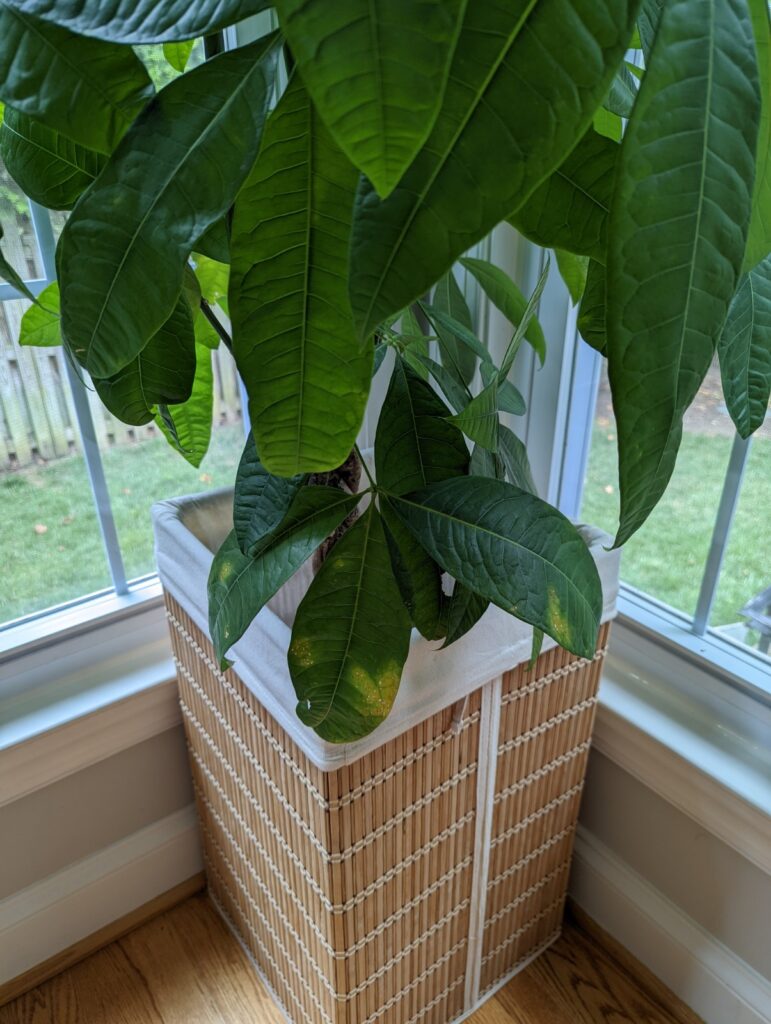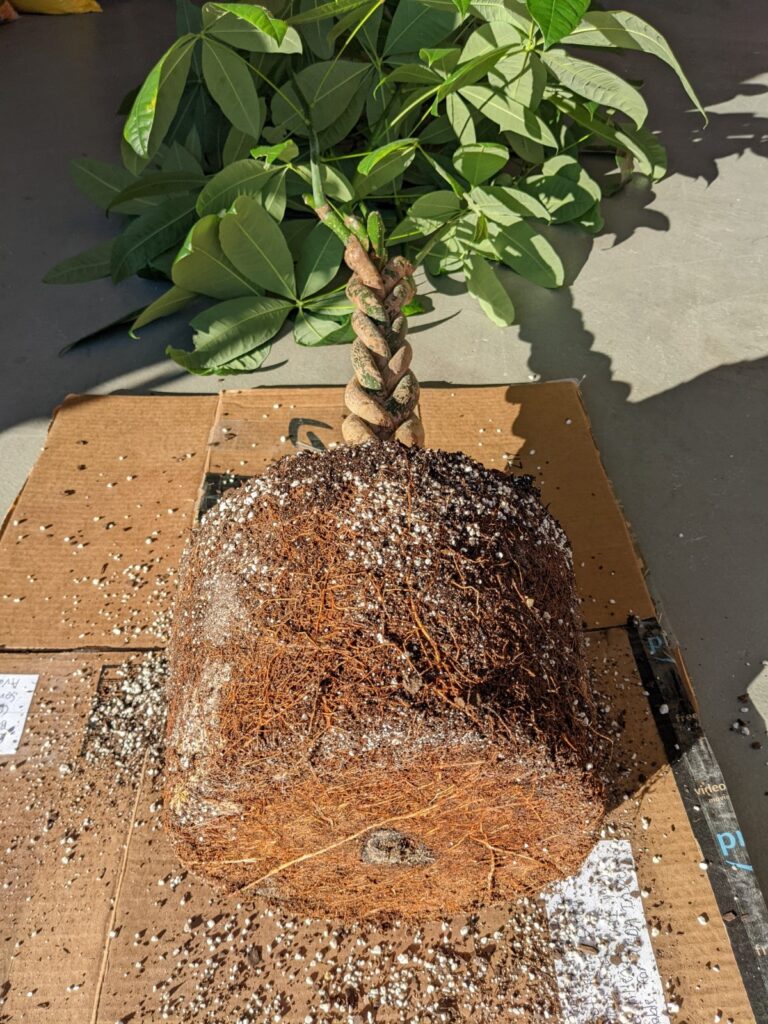Why Are My Money Tree Leaves Turning Yellow
I noticed some yellowing leaves on my big Money Tree recently. I follow a lot of plant and gardening forums and I swear half the questions are about yellow leaves. So if you're wondering, why are my Money Tree leaves turning yellow, read on. This post covers the main causes of yellowing leaves and how to deal with them.

Money Tree Leaves Turning Yellow
Water Issues
Underwatering and overwatering can cause your Money Tree to have yellow leaves. I use a cheap soil moisture meter every time I water to make sure I know how moist the soil is. Something simple like this soil moisture meter does the trick. I've used the same one for many years and it's definitely made me a better plant waterer because it helps you figure out the right amount of water for each plant and the right frequency of watering. If you don't like tools, your finger works too. You want to make sure the top inch or two of the soil feels dry before you water your plant.
In the wild, Money Trees actually grow in swamps, so they can deal with some moisture. In fact, I think they are a plant that's pretty forgiving when it comes to water issues. I'm guessing if you found my blog, that you probably have an indoor Money Plant though. If your indoor money plant leaves are turning yellow it could be from underwatering. Some other signs of underwatering are a general droopiness of the leaves. If you are underwatering, typically the leaves that turn yellow first are the oldest ones at the base of a trunk. The older leaves tend to be more susceptible to drying out.
Conversely, if the soil feels moist and it takes a really long time to dry out, you could be overwatering. The yellow leaves from overwatering are usually not concentrated at the base of the stems, but more evenly disbursed. Another sign of overwatering is usually yellowing from the tip of the leaf rather than the whole leaf all at once.
How to Fix Water Issues
If you believe that you have been underwatering your plant, just start watering more often or a larger quantity. Don't do both though, you could go too far the other way. Unfortunately, the yellow leaves on your Money Tree will not regain their green color. If you don't like the looks of the yellow leaves, it's fine to remove them. If you don't mind them, they'll eventually fall off on their own. One thing to watch out for if you have been underwatering is if the water just runs through your plant when you do try to water it. If so, your soil may have become hydrophobic. To try to fix this, stick your plant pot in a bowl or the sink with water and let the soil and roots soak up water from the base of the plant. This technique is called bottom watering.

It's harder to fix overwatered plants. If you suspect you have overwatered then you'll want to remove your Money Tree from its pot carefully. This will let you inspect the roots for root rot and it will also let the soil dry out more quickly. Money Tree roots are pretty fine as you can see from the picture above (this picture is not depicting overwatering or root rot, it's just showing what Money Tree roots look like). That can actually make it harder to tell if there's rot. You want to look for mushy dark brown roots, which is much easier to see when you have plant with big and fat roots. If you do find root rot, I have a whole post dedicated to fixing an overwatered plant if you want to follow along in more detail.
Fertilizing Issues
Fertilization can be the reason for Money Tree leaves turning yellow. Nutrients are the same as water, you can both overdo it and underdo it, and both could cause yellow leaves. However, under-fertilization is more likely to manifest as yellow leaves compared to over-fertilization. Interestingly, over-fertilization symptoms are often slow growth and maybe wilting, which often causes people to make their problems worse by fertilizing even more. A typical houseplant fertilizer has a balanced ratio of nitrogen, phosphorous, and potassium, or n-p-k, which are the numbers you see on the label of most plant fertilizers. Yellow leaves may be a symptom of a lack of nitrogen or potassium. Nitrogen is the nutrient that helps promote healthy foliage growth.
Under-fertilization may affect older leaves first, just like underwatering. Once it gets more severe, it will begin to affect all the leaves on your plant equally. Use soil rapitests to catch nutrient issues early. The tests allow you to test for ph and each nutrient individually. So you'll know the presence of each nutrient in your soil.
How to Fix Fertilization Issues
An overfertilized Money Tree should be flushed with water. The water will help remove some of the nutrients from the soil. However, this will also put you at risk of overwatering. Make sure your plant is in a sunny spot, in a well-draining pot, and maybe even put a gentle fan on it to help the soil dry out as well as possible after flushing.
To fix an under-fertilized plant you will need to fertilize it. Liquid fertilizers work best for quicker absorption versus solid pellets or sticks. If you don't opt for a soil rapitest that I linked earlier, it would be best to stick with a balanced fertilizer, which just means that it has the same number in the n-p-k ratio. If you know your plant's deficiency, you can find fertilizers that have higher ratios of nitrogen for example. Make sure to follow the instructions on the fertilizing product because many of them require dilution or that you water the plant beforehand.
Pests Can Cause Yellow Leaves
A wide variety of pests can attack Money Trees. The pests that most commonly attack leaves, causing leaf yellowing, are aphids, scale/mealybugs, spider mites, and thrips. Pests pierce the leaves to feed and ultimately destroy them. Pest damage usually appears spotty where the pests have attacked, so look out for yellow spots rather than more uniform yellowing. The picture below is a good example of what pest damage will look like. These leaves at the bottom had some damage from spider mites I had a while ago. The yellow is only now starting to spread and become more visible, so yellowing in the case of pests is not exactly an early warning system.

How to Fix Pest Issues
If you see a pest on your Money Tree, my condolences. Especially if you have a really big one like me. It is very difficult to get all the pests off when you have a ton of leaves. Quarantine your plant away from other healthy uninfested plants asap. Many of the pests can spread very quickly to neighboring plants. Speaking of, you need to check all of your plants for pests if you find them on one plant. Next, use a multipronged approach of removal and pesticide. Do your best to physically remove as many as you can. Most pests can be removed by a strong spray in the shower or with a hose. Scale and mealybugs require a more manual approach because they have an armor-like shell.
Organic pesticides like neem oil do well. I have personally used neem oil on spider mites many times. Nonorganic insecticidal soap also works well. The final key to eradication is that it isn't over when you think it is. You must repeat the removal and pesticide steps until you do not detect pests for over a week. They have short lifecycles so although you don't see them initially, their eggs may still be there ready to hatch.
Hopefully, this helps you figure out why your Money Tree has yellow leaves. Have any questions? Post them in the Comments section below.
Add new comment